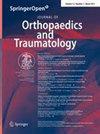使用钽骨架进行经椎间孔腰椎椎间融合术:采用改良后路技术重新分配腰椎前凸并恢复骶骨斜度
IF 3
2区 医学
Q1 ORTHOPEDICS
引用次数: 0
摘要
经椎间孔腰椎椎体间融合术(TLIF)是脊柱外科中常用的一种手术,与后路腰椎椎体间融合术(PLIF)相比,其优点是神经病变发生率较低。椎间关节融合术一直使用单一钽笼进行,通常用于PLIF。钽是一种特别用于骨科手术的金属。它具有与骨髓相似的弹性模量,并导致植入物的高初级稳定性。我们的研究是一项回顾性单中心观察性研究,评估改良TLIF技术中钽笼与后路内固定和自体和/或同源后外侧植骨的临床和放射学结果。该研究的目的是评估临床结果和腰椎前凸的增加或再分布。椎间关节融合术通常采用单一钽笼进行,通常用于PLIF,以降低神经系统风险。我们回顾性研究了2013年至2018年间由两位外科医生采用改良单侧TLIF入路治疗的105例患者。我们评估了77例患者的Oswestry残疾指数(ODI)、视觉模拟量表(VAS)对背痛、整体腰椎前凸、l4 -骶骨前凸、关节固定术后功能运动单元的节段性前凸、骨盆倾斜、骨盆发生率和骶骨斜度的影响。所有患者均患有III级或IV级Pfirrmann、不稳定或椎间孔椎板切除术后狭窄和/或I-II级退行性腰椎滑脱或低级别峡部腰椎滑脱。他们没有明显的矢状面不平衡,矢状面垂直轴(SVA) < 5mm。平均随访时间为30个月。我们取得了良好的临床效果,只有4例失败(5.2%)。此外,我们注意到腰椎前凸的再分布有统计学意义,L4-S1腰椎前凸的平均百分比增加为19.9% (P < 0.001), L4-S1 /腰椎前凸(LL)的平均百分比从0.53增加到0.63 (P < 0.001),骶骨斜率的平均百分比增加为7.6% (P < 0.001)。由于钽的特性,我们改良的单门静脉TLIF技术是一种有效的手术解决方案,可以获得实体关节融合术,恢复正确的腰椎前凸分布,同时减少神经系统并发症和失败次数。证据等级:4试验注册声明:回顾性观察性研究,无试验注册。本文章由计算机程序翻译,如有差异,请以英文原文为准。
Transforaminal lumbar interbody fusion with a tantalum cage: lumbar lordosis redistribution and sacral slope restoration with a modified posterior technique
Transforaminal lumbar interbody fusion (TLIF), a commonly used procedure in spine surgery, has the advantage of a lower incidence of nerve lesions compared to the posterior lumbar interbody fusion (PLIF) technique. The intersomatic arthrodesis has always been carried out with a single tantalum cage normally used for PLIF. Tantalum is a metal that is particularly used in orthopedic surgery. It has a modulus of elasticity similar to marrow and leads to high primary stability of the implant. Our study was a retrospective monocentric observational study evaluating clinical and radiological outcomes of tantalum cages in a modified TLIF technique with posterior instrumentation and autologous and/or homologous posterolateral bone grafting. The aim of the study was to evaluate clinical outcomes and the increase in or redistribution of lumbar lordosis. The intersomatic arthrodesis was always carried out with a single tantalum cage normally used for PLIF to reduce the neurological risk. We retrospectively studied 105 patients who were treated with a modified unilateral TLIF approach by two surgeons between 2013 and 2018. We evaluated the Oswestry Disability Index (ODI), Visual Analogue Scale (VAS) for back pain, global lumbar lordosis, lordosis of L4–sacrum, segmental lordosis of functional motion units that underwent arthrodesis, pelvic tilt, pelvic incidence, and the sacral slope in 77 patients. All patients were suffering from grade III or IV Pfirrmann, instability, or foraminal post-laminectomy stenosis and/or grade I–II degenerative spondylolisthesis or low-grade isthmic spondylolisthesis. They had no significant sagittal imbalance, with a sagittal vertical axis (SVA) of < 5 mm. The average follow-up duration was 30 months. We achieved excellent clinical results, with only four cases of failure (5.2%). Moreover, we noticed a statistically significant redistribution of lumbar lordosis, with an average percentage increase in L4–S1 lordosis equal to 19.9% (P < 0.001), an average increase in the L4–S1/Lumbar lordosis (LL) ratio from 0.53 to 0.63 (P < 0.001), and a mean percentage increase in sacral slope equal to 7.6% (P < 0.001). Thanks to the properties of tantalum, our modified single-portal TLIF technique is a valid surgical solution to obtain a solid arthrodesis and restore the correct lumbar lordosis distribution while reducing neurological complications and the number of failures. Level of evidence: 4 Trial registration statement: retrospective observational study, no trial registration.
求助全文
通过发布文献求助,成功后即可免费获取论文全文。
去求助
来源期刊

Journal of Orthopaedics and Traumatology
Medicine-Orthopedics and Sports Medicine
CiteScore
4.30
自引率
0.00%
发文量
56
审稿时长
13 weeks
期刊介绍:
The Journal of Orthopaedics and Traumatology, the official open access peer-reviewed journal of the Italian Society of Orthopaedics and Traumatology, publishes original papers reporting basic or clinical research in the field of orthopaedic and traumatologic surgery, as well as systematic reviews, brief communications, case reports and letters to the Editor. Narrative instructional reviews and commentaries to original articles may be commissioned by Editors from eminent colleagues. The Journal of Orthopaedics and Traumatology aims to be an international forum for the communication and exchange of ideas concerning the various aspects of orthopaedics and musculoskeletal trauma.
 求助内容:
求助内容: 应助结果提醒方式:
应助结果提醒方式:


